TOYOTA MIRAI 2018 Owners Manual (in English)
Manufacturer: TOYOTA, Model Year: 2018, Model line: MIRAI, Model: TOYOTA MIRAI 2018Pages: 464, PDF Size: 8.61 MB
Page 221 of 464

2215-5. Using the driving support systems
5
Driving
MIRAI_OM_USA_OM62025U■
Warning messages for the LDA system
Warning messages are used to indicate a system malfunction or to inform the
driver of the need for caution while driving. If a warning mess age is shown on
the multi-information display, read the message and follow the instructions.
Also, even if a warning message is displayed, it will not imped e normal driv-
ing.
WARNING
■ Before using the LDA system
Do not rely solely on the LDA system. The LDA system does not d rive the
vehicle automatically, nor does it reduce the amount of care you need to
take. As such, the driver must always assume full responsibilit y for under-
standing his/her surroundings, for operating the steering wheel to correct
the driving line, and for driving safely. Also, take occasional rests from
fatigue due to driving over long periods of time, etc.
Inappropriate or negligent driving could lead to an unexpected accident.
■ To avoid operating the LDA system by mistake
Switch the LDA system off using the LDA switch when not in use.
( P. 217)
■ Situations unsuitable for LDA system
Do not use the LDA system in any of the following situations.
Otherwise, the system may not function correctly and could result in an
accident.
● When driving with tire chains, a spare tire, or similar equipme nt
● When there are objects or structures along the roadside that mi ght be mis-
interpreted as lane markers (such as guardrails, a curb, reflec tor posts,
etc.)
● When driving on snowy roads
● When pavement lane markers are difficult to see due to rain, snow, fog,
sand, dirt, etc.
● When there are visible lines on the pavement from road repairs, or if the
remains of old lane markers are still visible on the road
● When driving on a road with lane closures due to maintenance, o r when
driving in a temporary lane
● When driving through construction areas
Page 222 of 464
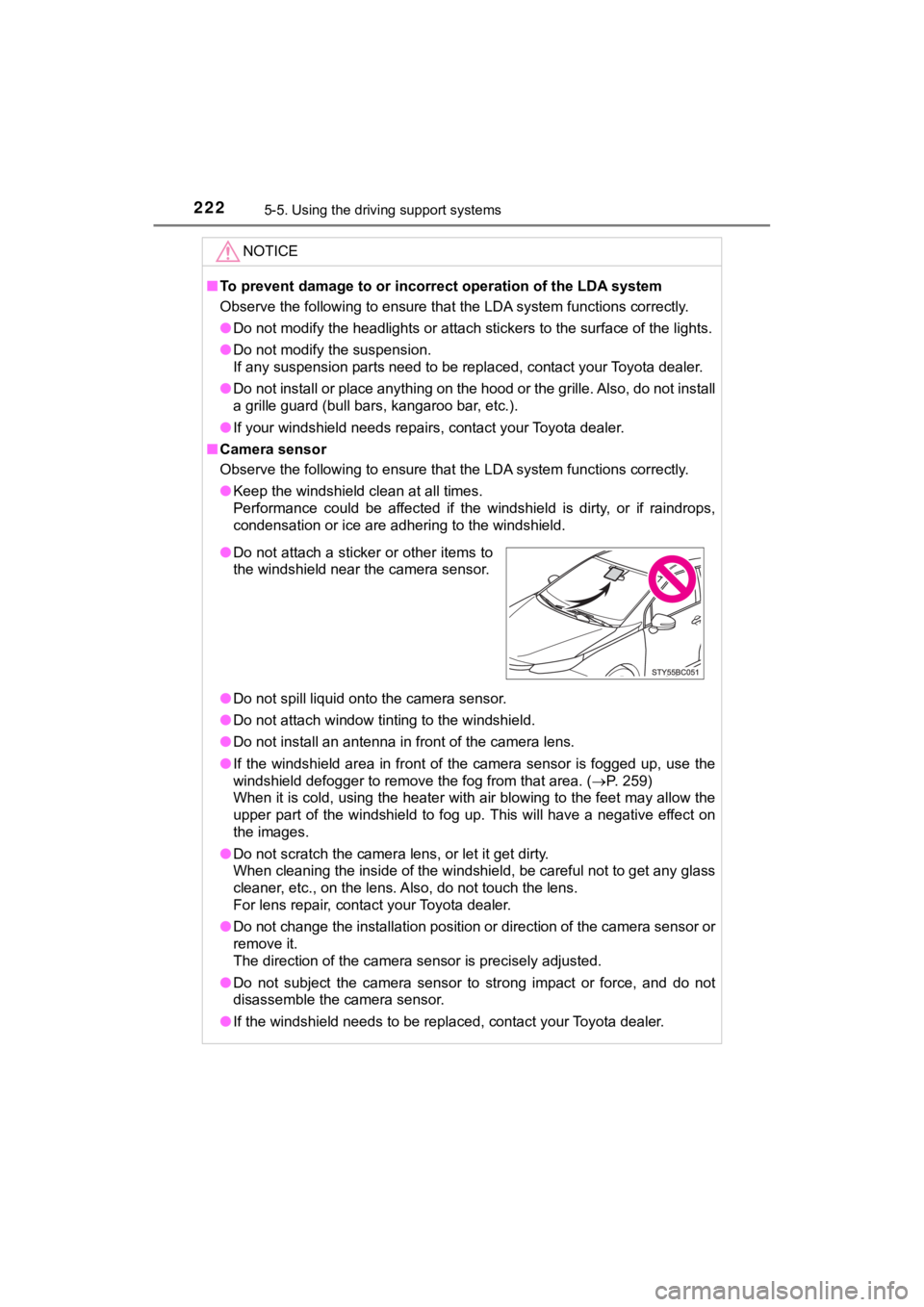
2225-5. Using the driving support systems
MIRAI_OM_USA_OM62025U
NOTICE
■To prevent damage to or incorr ect operation of the LDA system
Observe the following to ensure that the LDA system functions c orrectly.
● Do not modify the headlights or attach stickers to the surface of the lights.
● Do not modify the suspension.
If any suspension parts need to be replaced, contact your Toyota dealer.
● Do not install or place anything on the hood or the grille. Als o, do not install
a grille guard (bull bars, kangaroo bar, etc.).
● If your windshield needs repairs, contact your Toyota dealer.
■ Camera sensor
Observe the following to ensure that the LDA system functions c orrectly.
● Keep the windshield clean at all times.
Performance could be affected if the windshield is dirty, or if raindrops,
condensation or ice are adhering to the windshield.
● Do not spill liquid onto the camera sensor.
● Do not attach window tinting to the windshield.
● Do not install an antenna in front of the camera lens.
● If the windshield area in front of the camera sensor is fogged up, use the
windshield defogger to remove the fog from that area. ( P. 259)
When it is cold, using the heater with air blowing to the feet may allow the
upper part of the windshield to fog up. This will have a negative effect on
the images.
● Do not scratch the camera lens, or let it get dirty.
When cleaning the inside of the windshield, be careful not to g et any glass
cleaner, etc., on the lens. Also, do not touch the lens.
For lens repair, contact your Toyota dealer.
● Do not change the installation position or direction of the cam era sensor or
remove it.
The direction of the camera sensor is precisely adjusted.
● Do not subject the camera sensor to strong impact or force, and do not
disassemble the camera sensor.
● If the windshield needs to be replaced, contact your Toyota dea ler.
●Do not attach a sticker or other items to
the windshield near the camera sensor.
Page 223 of 464
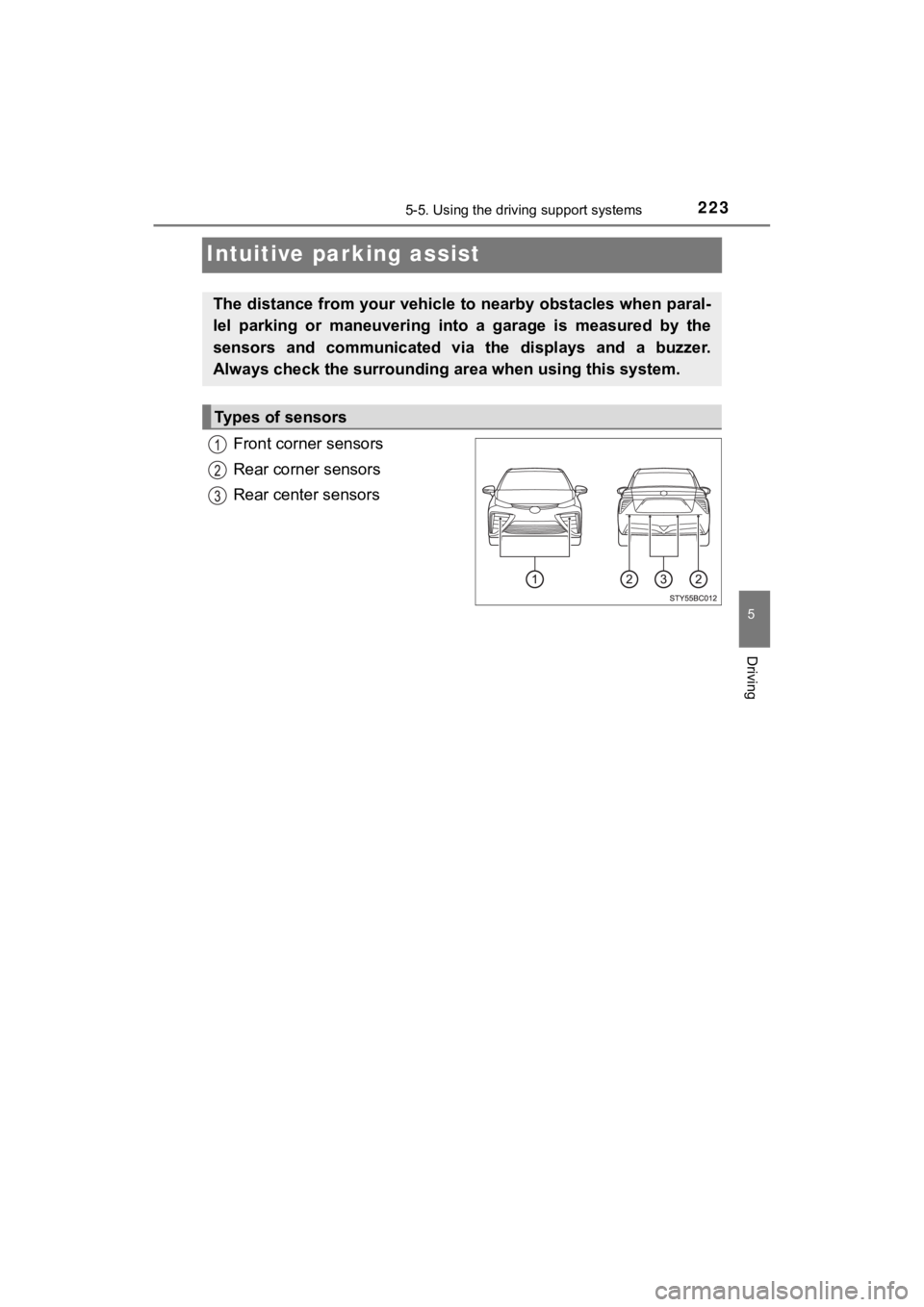
2235-5. Using the driving support systems
5
Driving
MIRAI_OM_USA_OM62025U
Intuitive parking assist
Front corner sensors
Rear corner sensors
Rear center sensors
The distance from your vehicle to nearby obstacles when paral-
lel parking or maneuvering into a garage is measured by the
sensors and communicated via the displays and a buzzer.
Always check the surrounding ar ea when using this system.
Types of sensors
Page 224 of 464
![TOYOTA MIRAI 2018 Owners Manual (in English) 2245-5. Using the driving support systems
MIRAI_OM_USA_OM62025U
ON (activate)/OFF (deactivate) can be changed by the [set-
tings display] for the Mult i-information Display (P. 1 0 7 ) TOYOTA MIRAI 2018 Owners Manual (in English) 2245-5. Using the driving support systems
MIRAI_OM_USA_OM62025U
ON (activate)/OFF (deactivate) can be changed by the [set-
tings display] for the Mult i-information Display (P. 1 0 7 )](/img/14/42617/w960_42617-223.png)
2245-5. Using the driving support systems
MIRAI_OM_USA_OM62025U
ON (activate)/OFF (deactivate) can be changed by the [set-
tings display] for the Mult i-information Display (P. 1 0 7 )
Press either or on the
meter control switches ( P. 1 0 8 )
and select
Each press of of the meter control switches, changes ON and
OFF. When ON is selected, the intuitive parking assist indicator
turns on.
Turning the intuitive pa rking assist system on
Page 225 of 464

2255-5. Using the driving support systems
5
Driving
MIRAI_OM_USA_OM62025U
When the sensors detect an obstacle, the following displays inform
the driver of the position and distance to the obstacle.
Front corner sensor operation
Rear corner sensor operation
Rear center sensor operation
Display
Page 226 of 464
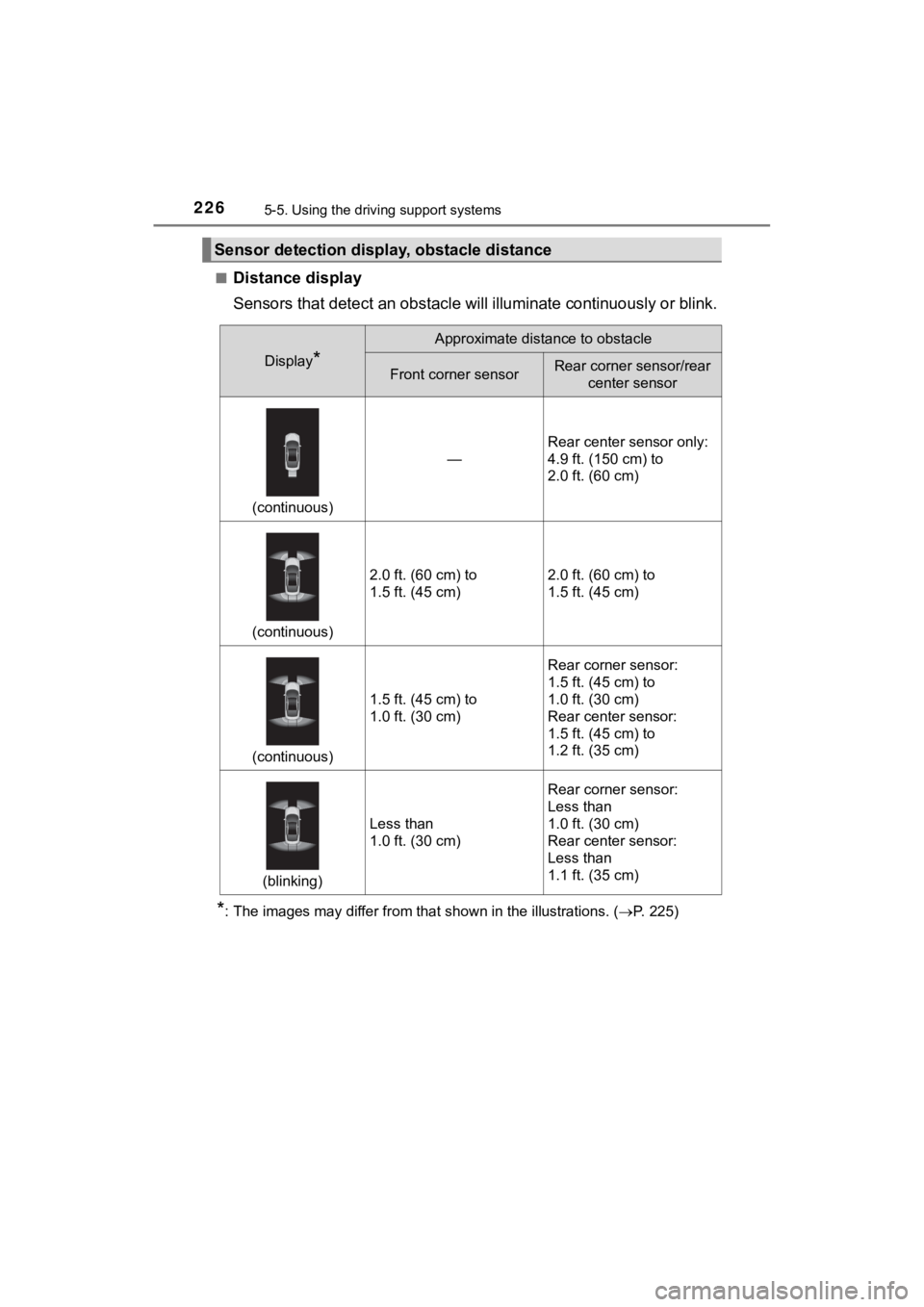
2265-5. Using the driving support systems
MIRAI_OM_USA_OM62025U■
Distance display
Sensors that detect
an obstacle will illuminate continuously or blink.
*: The images may differ from that shown in the illustrations. ( P. 225)
Sensor detection display, obstacle distance
Display*
Approximate distance to obstacle
Front corner sensorRear corner sensor/rear
center sensor
(continuous)
—
Rear center sensor only:
4.9 ft. (150 cm) to
2.0 ft. (60 cm)
(continuous)
2.0ft.(60cm) to
1.5ft.(45cm)2.0 ft. (60 cm) to
1.5 ft. (45 cm)
(continuous)
1.5ft.(45cm) to
1.0ft.(30cm)
Rear corner sensor:
1.5 ft. (45 cm) to
1.0 ft. (30 cm)
Rear center sensor:
1.5 ft. (45 cm) to
1.2 ft. (35 cm)
(blinking)
Less than
1.0ft.(30cm)
Rear corner sensor:
Less than
1.0 ft. (30 cm)
Rear center sensor:
Less than
1.1 ft. (35 cm)
Page 227 of 464
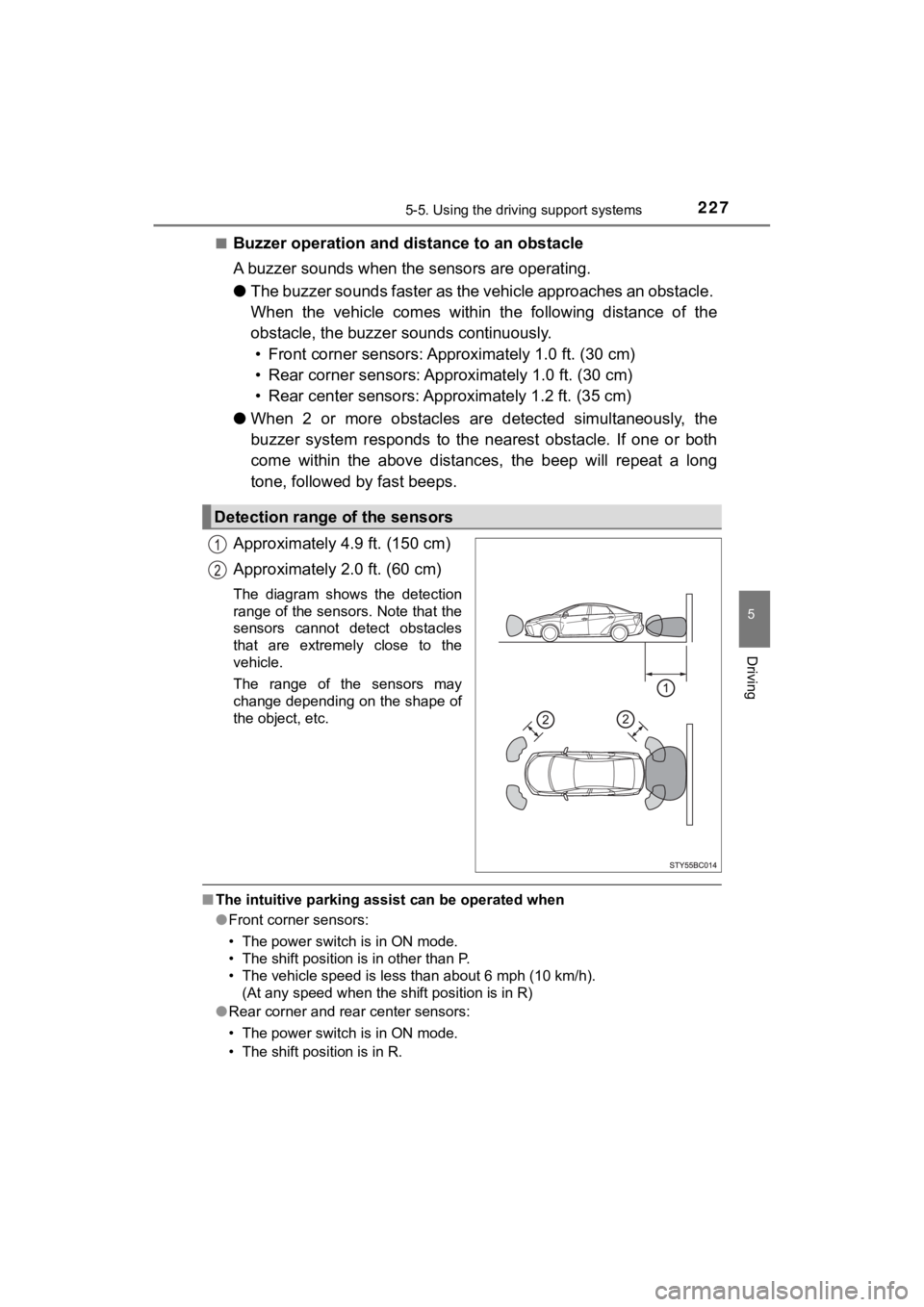
2275-5. Using the driving support systems
5
Driving
MIRAI_OM_USA_OM62025U■
Buzzer operation and di
stance to an obstacle
A buzzer sounds when the sensors are operating.
● The buzzer sounds faster as the vehicle approaches an obstacle.
When the vehicle comes within the following distance of the
obstacle, the buzzer sounds continuously.
• Front corner sensors: Appr oximately 1.0 ft. (30 cm)
• Rear corner sensors: Appr oximately 1.0 ft. (30 cm)
• Rear center sensors: Approximately 1.2 ft. (35 cm)
● When 2 or more obstacles are detected simultaneously, the
buzzer system responds to the nearest obstacle. If one or both
come within the above distances , the beep will repeat a long
tone, followed by fast beeps.
Approximately 4.9 ft. (150 cm)
Approximately 2.0 ft. (60 cm)
The diagram shows the detection
range of the sensors. Note that the
sensors cannot detect obstacles
that are extremely close to the
vehicle.
The range of the sensors may
change depending on the shape of
the object, etc.
■ The intuitive parking assist can be operated when
●Front corner sensors:
• The power switch is in ON mode.
• The shift position is in other than P.
• The vehicle speed is less than about 6 mph (10 km/h).
(At any speed when the shift position is in R)
● Rear corner and rear center sensors:
• The power switch is in ON mode.
• The shift position is in R.
Detection range of the sensors
Page 228 of 464

2285-5. Using the driving support systems
MIRAI_OM_USA_OM62025U■
Sensor detection information
●The sensor’s detection areas are limited to the areas around th e vehicle’s
bumper.
● Certain vehicle conditions and the surrounding environment may affect the
ability of a sensor to correctly detect an obstacle. Particular instances where
this may occur are listed below.
• There is dirt, snow or ice on the sensor. (Wiping the sensors will resolve
this problem.)
• The sensor is frozen. (Thawing the area will resolve this problem.)
In especially cold weather, if a sensor is frozen the screen ma y show an
abnormal display, or obstacles may not be detected.
• The sensor is covered in any way.
• The vehicle is leaning considerably to one side.
• On an extremely bumpy road, on an incline, on gravel, or on grass.
• The vicinity of the vehicle is noisy due to vehicle horns, motorcycle
engines, air brakes of large vehicles, or other loud noises pro ducing ultra-
sonic waves.
• There is another vehicle equipped with parking assist sensors in the
vicinity.
• The sensor is coated with a sheet of spray or heavy rain.
• The vehicle is equipped with a fender pole or wireless antenna .
• Towing eyelets are installed.
• The bumper or sensor receives a strong impact.
• A backlit license plate, license plate holder, etc., are insta lled.
• The vehicle is approaching a tall or curved curb.
• In harsh sunlight or intense cold weather.
• The area directly under the bumpers is not detected.
• If obstacles draw too close to the sensor.
• A non-genuine Toyota suspension (lowered suspension etc.) is i nstalled.
• People may not be detected if they are wearing certain types o f clothing.
In addition to the examples above, there are instances in which, because of
their shape, signs and other objects may be judged by a sensor to be closer
than they are.
● The shape of the obstacle may prevent a sensor from detecting i t. Pay par-
ticular attention to the following obstacles:
• Wires, fences, ropes, etc.
• Cotton, snow and other materials that absorb sound waves
• Sharply-angled objects
• Low obstacles
• Tall obstacles with upper sections projecting outwards in the direction of your vehicle
Page 229 of 464

2295-5. Using the driving support systems
5
Driving
MIRAI_OM_USA_OM62025U●
The following situations may occur during use.
• Depending on the shape of the obstacle and other factors, the detection
distance may shorten, or detection may be impossible.
• Obstacles may not be detected if they are too close to the sen sor.
• There will be a short delay between obstacle detection and dis play. Even
at slow speeds, there is a possibility that the obstacle will c ome within the
sensor’s detection areas before the display is shown and the bu zzer
sounds.
• Thin posts or objects lower than the sensor may not be detecte d when
approached, even if they have been detected once.
• It might be difficult to hear beeps due to the volume of audio system or air
flow noise of the air conditioning system.
■ If “Clean Parking Assist Sensor” is displayed on the multi-information
display
A sensor may be dirty or covered with snow or ice. In such case s, if it is
removed from the sensor, the system should return to normal.
Also, due to the sensor being frozen at low temperatures, a mal function dis-
play may appear or an obstacle may not be detected. If the sens or thaws out,
the system should return to normal.
■ If “Parking Assist Malfunction” is displayed on the multi-information dis-
play
Depending on the malfunction of the sensor, the device may not be working
normally.
Have the vehicle inspected by your Toyota dealer.
■ Customization
Some functions can be customized.
(Customizable features: P. 440)
■ Certification for the intuitive parking assist
This device complies with Part 15 of the FCC Rules. Operation i s subject to
the following two conditions: (1) This device may not cause har mful interfer-
ence, and (2) This device must accept any interference received, including
interference that may cause undesired operation.
Page 230 of 464
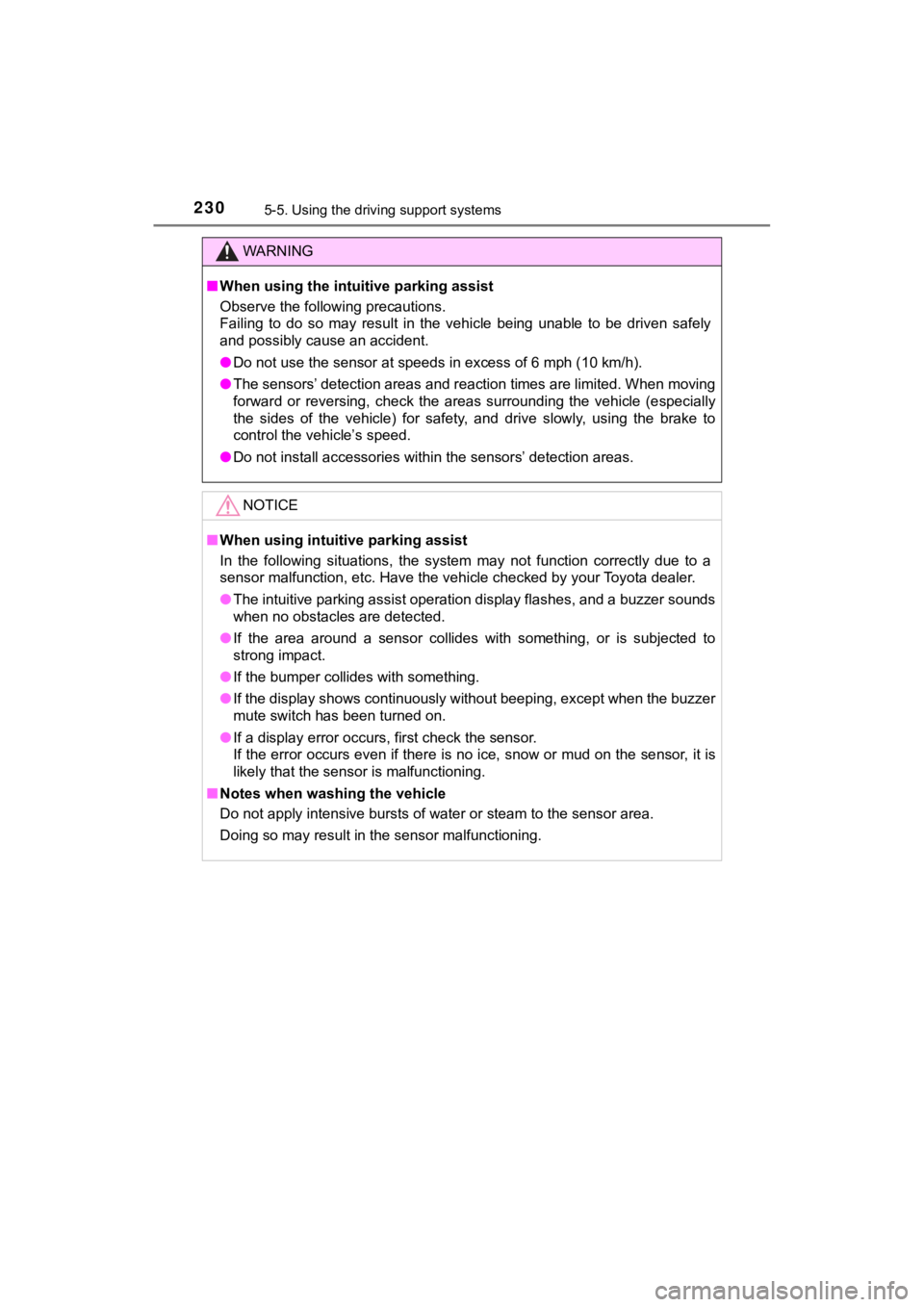
2305-5. Using the driving support systems
MIRAI_OM_USA_OM62025U
WARNING
■When using the intuitive parking assist
Observe the following precautions.
Failing to do so may result in the vehicle being unable to be d riven safely
and possibly cause an accident.
● Do not use the sensor at speeds in excess of 6 mph (10 km/h).
● The sensors’ detection areas and reaction times are limited. When moving
forward or reversing, check the areas surrounding the vehicle ( especially
the sides of the vehicle) for safety, and drive slowly, using t he brake to
control the vehicle’s speed.
● Do not install accessories within the sensors’ detection areas.
NOTICE
■When using intuitive parking assist
In the following situations, the system may not function correctly due to a
sensor malfunction, etc. Have the vehicle checked by your Toyot a dealer.
● The intuitive parking assist operation display flashes, and a b uzzer sounds
when no obstacles are detected.
● If the area around a sensor collides with something, or is subjected to
strong impact.
● If the bumper collides with something.
● If the display shows continuously without beeping, except when the buzzer
mute switch has been turned on.
● If a display error occurs, first check the sensor.
If the error occurs even if there is no ice, snow or mud on the sensor, it is
likely that the sensor is malfunctioning.
■ Notes when washing the vehicle
Do not apply intensive bursts of water or steam to the sensor a rea.
Doing so may result in the sensor malfunctioning.